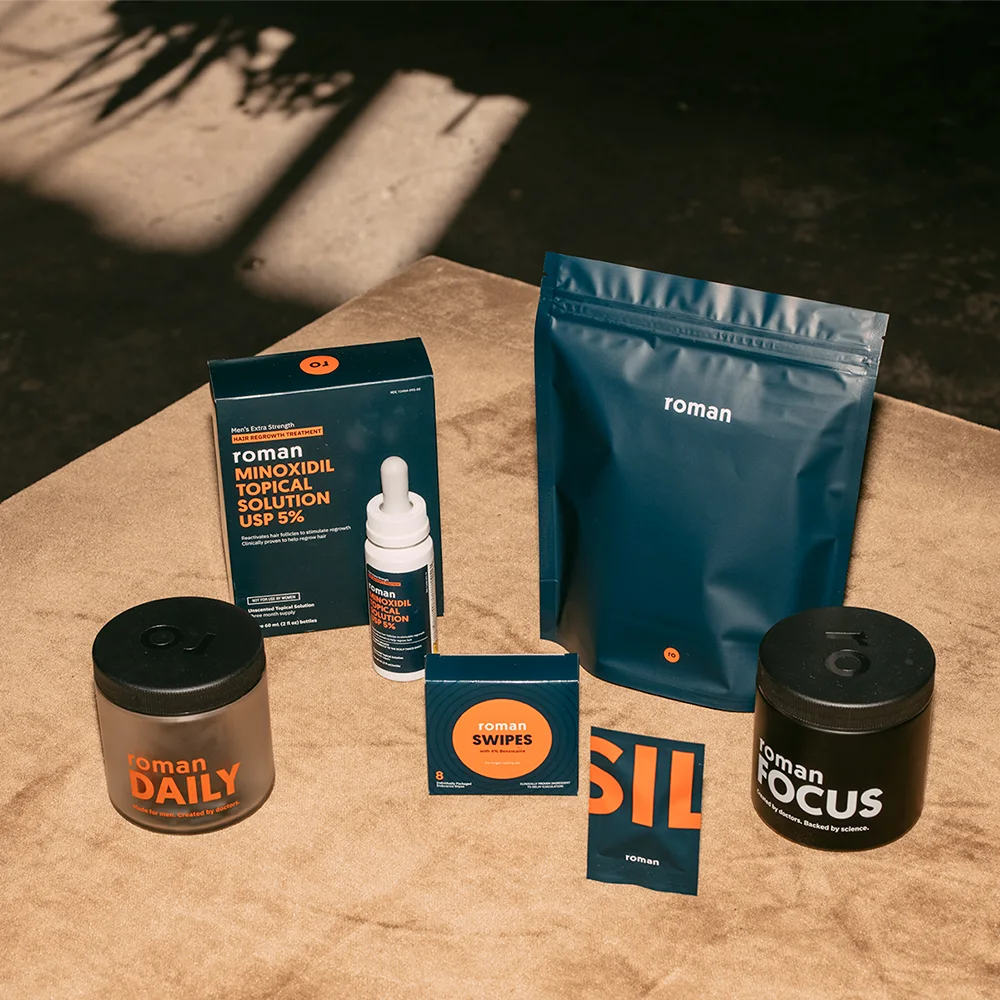Here's what we'll cover
Here's what we'll cover
You may have heard of this condition before. You may have seen it or experienced it yourself. You might be one of the hundreds of people each week who search online for “how to get rid of man boobs.”
The scientific term for this condition is gynecomastia. It might be uncomfortable to address, but it may help to know that it’s a relatively common phenomenon that’s particularly prevalent during puberty. While gynecomastia usually resolves on its own, if it persists, it may be the result of a medication or underlying health condition.
What is gynecomastia?
Gynecomastia is an enlargement of one or both breasts in a biological male. It often occurs when hormone levels change, making it common in infants right after they’re born, in adolescents during puberty, and in older age as testosterone levels naturally drop (Sansone, 2017).
The structure of breast tissue is the same in men and women. There’s glandular tissue and fat tissue. Typically, biological males don’t experience the same hormonal stimulation that causes a woman's breasts to grow.
However, if there’s a shift in those hormones, males can experience glandular tissue growth as well. It’s sometimes slightly painful or uncomfortable but is usually harmless––although it can certainly cause emotional distress. That said, it's important to know when to talk to a healthcare professional about gynecomastia to see if treatment is required.
How do you know if you have gynecomastia?
First, it’s helpful to figure out if you really have gynecomastia. This might sound like a silly question––if you see breast enlargement, then you have gynecomastia, right? But that’s not always the case.
A buildup of fat tissue in the breast can look very much like glandular tissue, but it isn’t classified as gynecomastia. This condition has an even longer scientific name (pseudogynecomastia) and is usually the result of carrying extra weight.
You can distinguish between body fat and glandular tissue by examining your own breasts. Start by lying on your back and gently squeezing the tissue below and around the nipple. Soft, squishy tissue with no swelling or lumps is more likely pseudogynecomastia, while firm, rubbery round swelling near the nipple is often gynecomastia (Braunstein, 2007).
Causes of gynecomastia
There are a number of things that can cause gynecomastia, some more common than others. In most cases the cause is unknown. While weight gain causes fat to distribute in different areas including the chest (like in pseudogynecomastia), the fat tissue itself produces increased estrogen, which then triggers gynecomastia.
Less commonly, gynecomastia can be a sign of an underlying medical condition like liver disease, thyroid disease, kidney disease, testicular tumors, or breast cancer. It can also result from a condition called hypogonadism, in which your body does not make enough testosterone (Sansone, 2017).
Prescription drugs, over-the-counter medications, and recreational substances are the most common causes of gynecomastia. Let’s review a few of the more common ones:
Acid blockers: Medications for acid reflux, such as H2-blockers (like cimetidine) and proton pump inhibitors (like omeprazole) can cause side effects including gynecomastia.
Cholesterol medications: Prescription medications called statins can lower your cholesterol levels. Since your body uses cholesterol to make testosterone, statins can cause hormonal imbalances and gynecomastia.
Finasteride: Also known under the brand name Propecia, finasteride is a drug used to treat hair loss. Finasteride affects sex hormone levels, which can result in gynecomastia in one or both breasts.
HIV medications: Some people take medications called highly active antiretroviral therapy (HAART) for HIV infections. Certain HAART medications like efavirenz cause gynecomastia, though scientists aren’t exactly sure why (Mira, 2004).
Recreational substances: Anabolic steroids are one of the most common recreational drugs linked to gynecomastia. Marijuana may also cause breast enlargement. Opioids (including heroin and methadone) and alcohol can also modify hormone levels, triggering gynecomastia.
Treatment options
Gynecomastia often goes away on its own. Lifestyle modifications like weight loss, adhering to a healthy diet, reducing alcohol intake, and getting regular exercise can help––although those won’t always solve the problem.
Gynecomastia that appears during puberty usually disappears on its own within six months or less. If symptoms last longer than 12 months, it may require medical evaluation.
Switch your medication
If you have gynecomastia caused by a medication you’re taking, speak with a healthcare provider about other options. While not every drug has an alternative, many do. It’s important that you don’t stop any medications before consulting with a healthcare provider.
Testosterone
If hypogonadism or low levels of sex hormones is the source of your gynecomastia, testosterone replacement therapy can help. Keep in mind this treatment isn’t useful for other types of gynecomastia and in some cases can make the condition worse.
Estrogen blockers
Since high estrogen levels can cause gynecomastia, healthcare providers sometimes treat it with drugs like tamoxifen, a drug that blocks estrogen and is commonly used to treat breast cancer (Johnson, 2009). One small study done in the '80s showed that tamoxifen reversed gynecomastia in 84% of study participants (Alagaratnam, 1987).
Gynecomastia surgery
Sometimes gynecomastia doesn’t resolve on its own or respond to medications. If this happens, you still have another option: male breast reduction surgery.
A surgeon can perform several different procedures. One uses a type of liposuction to remove excess fatty and glandular tissue with minimal incisions and scars (Baumann, 2018).
When should I call a doctor?
Gynecomastia itself usually isn’t dangerous. However, many conditions can cause it that may need addressing. If you’re unsure of the source, it’s extremely painful, or you have large, hard, or irregular lumps or discharge from your nipples, talk to a healthcare provider who can help figure out the source.
Gynecomastia can be frustrating, but it can be fixed. Often times it just goes away on its own. Your healthcare provider can help you identify the cause of your gynecomastia and decide on the best strategy to manage it.
DISCLAIMER
If you have any medical questions or concerns, please talk to your healthcare provider. The articles on Health Guide are underpinned by peer-reviewed research and information drawn from medical societies and governmental agencies. However, they are not a substitute for professional medical advice, diagnosis, or treatment.
Alagaratnam, T. T. (1987). Idiopathic gynecomastia treated with tamoxifen: a preliminary report. Clinical Therapeutics, 9 (5), 483–487. Retrieved from https://pubmed.ncbi.nlm.nih.gov/3664552/
Batteux, B., Llopis, B., Muller, C., Khouri, C., Moragny, J., Liabeuf, S., et al. (2020). The drugs that mostly frequently induce gynecomastia: A national case - noncase study. Therapie , 75 (3), 225–238. doi: 10.1016/j.therap.2019.06.001. Retrieved from https://pubmed.ncbi.nlm.nih.gov/31471065/
Braunstein, G. D. (2007). Clinical practice. Gynecomastia. The New England Journal of Medicine , 357 (12), 1229–1237. doi: 10.1056/NEJMcp070677. Retrieved from https://pubmed.ncbi.nlm.nih.gov/17881754/
Baumann, K. (2018). Gynecomastia - Conservative and Surgical Management. Breast care (Basel, Switzerland) , 13 (6), 419–424. doi: 10.1159/000494276. Retrieved from https://pubmed.ncbi.nlm.nih.gov/30800036/
Carlin, B. I., Seftel, A. D., Resnick, M. I., & Findlay, J. (1997). Finasteride induced gynecomastia. The Journal of Urology , 158 (2), 547. Retrieved from https://pubmed.ncbi.nlm.nih.gov/9224349/
Cordova, A., & Moschella, F. (2008). Algorithm for clinical evaluation and surgical treatment of gynaecomastia. Journal of Plastic, Reconstructive & Aesthetic Surgery , 61 (1), 41–49. doi: 10.1016/j.bjps.2007.09.033. Retrieved from https://pubmed.ncbi.nlm.nih.gov/17983883/
Costanzo, P. R., Pacenza, N. A., Aszpis, S. M., Suárez, S. M., Pragier, U. M., Usher, J., et al. (2018). Clinical and Etiological Aspects of Gynecomastia in Adult Males: A Multicenter Study. BioMed research International , 8364824. doi: 10.1155/2018/8364824. Retrieved from https://pubmed.ncbi.nlm.nih.gov/30003107/
Cuhaci, N., Polat, S. B., Evranos, B., Ersoy, R., & Cakir, B. (2014). Gynecomastia: Clinical evaluation and management. Indian Journal of Endocrinology and Metabolism, 18 (2), 150–158. doi: 10.4103/2230-8210.129104. Retrieved from https://www.ncbi.nlm.nih.gov/pmc/articles/PMC3987263/#ref6
Czajka-Oraniec, I., Zgliczynski, W., Kurylowicz, A., Mikula, M., & Ostrowski, J. (2008). Association between gynecomastia and aromatase (CYP19) polymorphisms. European Journal of Endocrinology , 158 (5), 721–727. doi: 10.1530/EJE-07-0556. Retrieved from https://pubmed.ncbi.nlm.nih.gov/18426832/
Deepinder, F., & Braunstein, G. D. (2012). Drug-induced gynecomastia: an evidence-based review. Expert Opinion on Drug Safety , 11 (5), 779–795. doi: 10.1517/14740338.2012.712109. Retrieved from https://pubmed.ncbi.nlm.nih.gov/22862307/
Dickson, G. (2012). Gynecomastia. American Family Physician , 85 (7), 716–722. Retrieved from https://pubmed.ncbi.nlm.nih.gov/18098387/
Ferrando, J., Grimalt, R., Alsina, M., Bulla, F., & Manasievska, E. (2002). Unilateral gynecomastia induced by treatment with 1 mg of oral finasteride. Archives of Dermatology , 138 (4), 543-544. Retrieved from https://pubmed.ncbi.nlm.nih.gov/11939831/
Johnson, R. E., & Murad, M. H. (2009). Gynecomastia: pathophysiology, evaluation, and management. Mayo Clinic Proceedings , 84 (11), 1010–1015. doi: 10.1016/S0025-6196(11)60671-X. Retrieved from https://pubmed.ncbi.nlm.nih.gov/19880691/
Kanakis, G. A., Nordkap, L., Bang, A. K., Calogero, A. E., Bártfai, G., Corona, G., et al. (2019). EAA clinical practice guidelines-gynecomastia evaluation and management. Andrology , 7 (6), 778–793. doi: 10.1111/andr.12636. Retrieved from https://pubmed.ncbi.nlm.nih.gov/31099174/
Khan, M., Khan, S. A., Ubaid, M., Shah, A., Kousar, R., & Murtaza, G. (2018). Finasteride Topical Delivery Systems for Androgenetic Alopecia. Current Drug Delivery , 15 (8), 1100–1111. doi: 10.2174/1567201815666180124112905. Retrieved from https://pubmed.ncbi.nlm.nih.gov/29366416/
Lee, S. G., Park, P. J., Lee, S. R., Koo, B. H., Byun, G. Y., Kim, M. J., et al. (2019). Influence of Postoperative Finasteride Therapy on Recurrence of Gynecomastia After Mastectomy in Men Taking Finasteride for Alopecia. American Journal of Men's Health , 13 (5). doi: 10.1177/1557988319871423. Retrieved from https://pubmed.ncbi.nlm.nih.gov/31552775/
Leung, A., & Leung, A. (2017). Gynecomastia in Infants, Children, and Adolescents. Recent Patents on Endocrine, Metabolic & Immune Drug Discovery , 10 (2), 127–137. doi:10.2174/1872214811666170301124033. Retrieved from https://pubmed.ncbi.nlm.nih.gov/28260521/
Lorek, M., Tobolska-Lorek, D., Kalina-Faska, B., Januszek-Trzciakowska, A., & Gawlik, A. (2019). Clinical and Biochemical Phenotype of Adolescent Males with Gynecomastia. Journal of Clinical Research in Pediatric Endocrinology , 11 (4), 388–394. doi: 10.4274/jcrpe.galenos.2019.2019.0027. Retrieved from https://www.ncbi.nlm.nih.gov/pmc/articles/PMC6878348/#ref17
Mansouri, P., Farshi, S., & Safar, F. (2009). Finasteride-induced gynecomastia. Indian Journal of Dermatology, Venereology and Leprology , 75 (3), 309–310. doi: 10.4103/0378-6323.51273. Retrieved from https://pubmed.ncbi.nlm.nih.gov/19439893/










